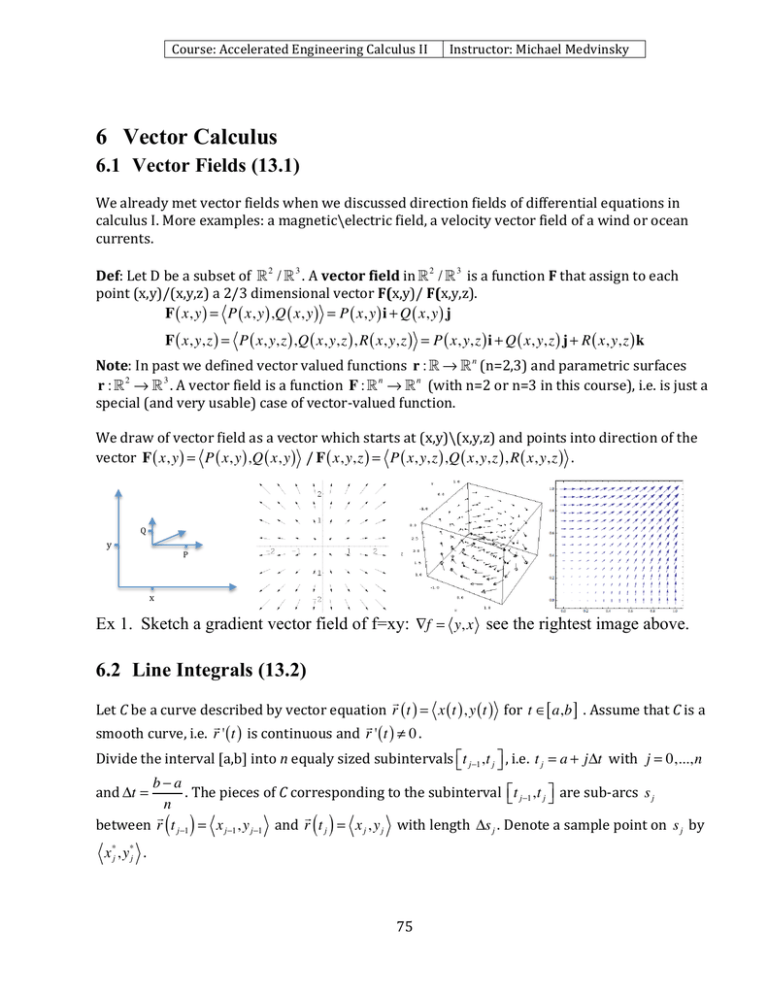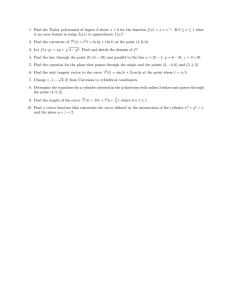Document 11901929
advertisement

Course: Accelerated Engineering Calculus II Instructor: Michael Medvinsky 6 Vector Calculus 6.1 Vector Fields (13.1) We already met vector fields when we discussed direction fields of differential equations in calculus I. More examples: a magnetic\electric field, a velocity vector field of a wind or ocean currents. Def: Let D be a subset of 2 / 3 . A vector field in 2 / 3 is a function F that assign to each point (x,y)/(x,y,z) a 2/3 dimensional vector F(x,y)/ F(x,y,z). F ( x, y ) = P ( x, y ) ,Q ( x, y ) = P ( x, y ) i + Q ( x, y ) j F ( x, y, z ) = P ( x, y, z ) ,Q ( x, y, z ) , R ( x, y, z ) = P ( x, y, z ) i + Q ( x, y, z ) j + R ( x, y, z ) k Note: In past we defined vector valued functions r : → n (n=2,3) and parametric surfaces r : 2 → 3 . A vector field is a function F : n → n (with n=2 or n=3 in this course), i.e. is just a special (and very usable) case of vector-­‐valued function. We draw of vector field as a vector which starts at (x,y)\(x,y,z) and points into direction of the vector F ( x, y ) = P ( x, y ) ,Q ( x, y ) / F ( x, y, z ) = P ( x, y, z ) ,Q ( x, y, z ) , R ( x, y, z ) . Q y P x Ex 1. Sketch a gradient vector field of f=xy: ∇f = y, x see the rightest image above. 6.2 Line Integrals (13.2) Let C be a curve described by vector equation r ( t ) = x ( t ) , y ( t ) for t ∈[ a,b ] . Assume that C is a smooth curve, i.e. r ' ( t ) is continuous and r ' ( t ) ≠ 0 . Divide the interval [a,b] into n equaly sized subintervals ⎡⎣t j−1 ,t j ⎤⎦ , i.e. t j = a + jΔt with j = 0,...,n b−a . The pieces of C corresponding to the subinterval ⎡⎣t j−1 ,t j ⎤⎦ are sub-­‐arcs s j n between r t j−1 = x j−1 , y j−1 and r t j = x j , y j with length Δs j . Denote a sample point on s j by and Δt = ( ) ( ) x *j , y*j . 75 Course: Accelerated Engineering Calculus II Instructor: Michael Medvinsky Consider that a function f(x,y) is defined on all points of the curve C. The following sum looks n ( ) very similar to Reimann sum: ∑ f x *j , y*j Δs j j=1 Def: If f is defined on a smooth curve C given by r ( t ) = x ( t ) , y ( t ) or r ( t ) = x ( t ) , y ( t ) , z ( t ) , then the line\contour\path\curve integral is defined by: ( n ) n * * f ( x, y ) ds = ∫ f ( x, y ) ds = lim ∑ f x j , y j Δs j ∫ C n→∞ C j=1 ( ) * * * ∫ f ( x, y, z ) ds = lim ∑ f x j , y j , z j Δs j or n→∞ C j=1 if the limit exists. Reminder: The length of the curve C is given by 2 b 2 b ∫ f ( x, y ) ds = ∫ C a 2 2 ⎛ dx ⎞ ⎛ dy ⎞ ⎛ dz ⎞ L = ∫ ⎜ ⎟ + ⎜ ⎟ + ⎜ ⎟ dt ⎝ dt ⎠ ⎝ dt ⎠ ⎝ dt ⎠ a or 2 b 2 ds ⎛ dx ⎞ ⎛ dy ⎞ f ( x ( t ) , y ( t )) dt = ∫ f ( x ( t ) , y ( t )) ⎜ ⎟ + ⎜ ⎟ dt ⎝ dt ⎠ ⎝ dt ⎠ dt a b ∫ f ( x, y, z ) ds = ∫ C 2 b ⎛ dx ⎞ ⎛ dy ⎞ L = ∫ ⎜ ⎟ + ⎜ ⎟ dt ⎝ dt ⎠ ⎝ dt ⎠ a Thm: If f is continues then a or 2 b 2 2 ds ⎛ dx ⎞ ⎛ dy ⎞ ⎛ dz ⎞ f ( x ( t ) , y ( t ) , z ( t )) dt = ∫ f ( x ( t ) , y ( t ) , z ( t )) ⎜ ⎟ + ⎜ ⎟ + ⎜ ⎟ dt ⎝ dt ⎠ ⎝ dt ⎠ ⎝ dt ⎠ dt a regardless of the parameterization as long as the curve traversed exactly once between a and b , i.e. it doesn’t wind circles. b b Note: One can rewrite the formulas above as L = ∫ r ' ( t ) dt and ∫ f ( x, y, z ) ds = ∫ f ( r (t )) r '(t ) dt a C a Ex 2. Let C be a curve defined by r (t) = 2 cost,2sint , 0 ≤ t ≤ π ∫x C π 2 ( −2sint ) + ( 2 cost ) y ds = ∫ 4 cos t ⋅ 2sint ⋅ 2 2 0 2 π dt = 16 ∫ cos t ⋅sint dt 2 0 u=cost du=− sintdt = 1 16 ∫ u 2 du = t=0⇒u=1 t=π ⇒u=−1 −1 Ex 3. Let C be a curve defined by r (t) = −t, 3 + 3t,6 + 5t , − 1 ≤ t ≤ 0 0 32 3 0 35 35 2 C −1 −1 Def: Given C j ,1 ≤ j ≤ n are smooth curves the curve C = C1 ∪ C2 ∪ ...∪ Cn called piecewise smooth. ∫ (x + 2y + 4z)ds = ∫ ( −t + 6 + 6t + 24 + 20t ) 1+ 9 + 25 dt = 35 ∫ 25t + 30 dt = n f r t ds = Thm: For a piecewise smooth C = C1 ∪ C2 ∪ ...∪ Cn we have ( ) ( ) ∑ ∫ f ( r (t )) ds . ∫ j=1 C j C C1 : r (t) = Ex 4. ∫ C1 ∪C2 ∫( C2 : r (t) = 1,2,−5t , − 1 ≤ t ≤ 0 8t, 4t,5t , 0 ≤ t ≤ 1, x + y + z ds = ∫ x + y + z ds + ∫ x + y + z ds = C1 1 8t + 4t + 5t 0 ) C2 0 8 + 16 + 25 dt + ∫ (1+ 2 − 5t ) 0 2 + 0 2 + 25 dt = −1 ( ) 1 0 7 9+ 8 ⎛ t2 t2 ⎞ 25 7 9 + 8 ∫ t dt + 5 ∫ 3 − 5t dt = 7 9 + 8 + 5 ⎜ 3t − 5 ⎟ = + 35 + 20 2 ⎠ −1 2 2 ⎝ 0 −1 ( ) 1 0 ( ) 76





